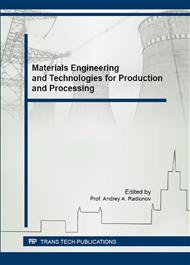[1]
N. Li, K. Yanagisawa, Controlling the morphology of yttrium oxide through different precursors synthesized by hydrothermal method, J. Solid State Chem. 181 (2008) 1738-1743.
DOI: 10.1016/j.jssc.2008.03.031
Google Scholar
[2]
S.J. Wang, S.L. Zho, X.J. Ou-Yang et al., Y(OH)3 and Y2O3 with novel structures: Formation and mechanism, Mat. Sc. Eng. B. 162 (2009) 200-204.
Google Scholar
[3]
N. Zhang, X. Liu, Ran Yi et al., Selective and Controlled Synthesis of Single-Crystalline Yttrium Hydroxide/Oxide Nanosheets and Nanotubes, J. Phys. Chem. C. 112 (2008) 17788-17795.
DOI: 10.1021/jp803831g
Google Scholar
[4]
E.P. Yudina, A.V. Frolova, I.V. Krivtsov and V.V. Avdin, Analysis of products formed in hydrothermal processing of yttrium nitrate and yttrium chloride, Bull. South Ural State Univ. Ser. Chem., 7 1 (2015) 51-56.
Google Scholar
[5]
G. Kimmel, J. Zabicky, E. Goncharov et al., Formation and characterization of nanocrystalline binary oxides of yttrium and rare earths metals, J. All. Comp., 423 (2006) 102-106.
DOI: 10.1016/j.jallcom.2005.12.037
Google Scholar
[6]
Y. Xi, R. J. Davis Intercalation of Ethylene Glycol into Yttrium Hydroxide Layered Materials Inorg. Chem. 49 (2010) 3888-3895.
DOI: 10.1021/ic1000478
Google Scholar
[7]
T. Li, J. Wentao, S. Qiliang, L. Jin. Synthesis and characterization of branched yttrium hydroxide fluoride microcrystals with hierarchical tubular structure, J. Rare Earths, 30 4 (2012) 378-382.
DOI: 10.1016/s1002-0721(12)60054-4
Google Scholar
[8]
Q. Tang, Zh. Liu, Sh. Li et al., Synthesis of yttrium hydroxide and oxide nanotubes, J. Cryst. Growth 259 (2003) 208-214.
Google Scholar
[9]
V.V. Avdin, T.V. Safonova, A.A. Aksyenova and A.A. Limar, Formation of Yttrium and Zirconium oxyhidrates with nonionic surfactant presence, Bull. South Ural State Univ. Ser. Chem., 11 (2010) 66-71.
Google Scholar
[10]
V.K. Ivanov, A.E. Baranchikov, A.S. Vanetsev et al., Effect of hydrothermal and ultrasonic/hydrothermal treatment on the phase composition and micromorphology of yttrium hydroxocarbonate, Rus. J. Inorg. Chem., 52 (2007) 1321-1327.
DOI: 10.1134/s003602360709001x
Google Scholar
[11]
V.V. Avdin, I.V. Krivtsov, E.A. Katsubo and A.V. Mnyakina, Formation of lamellar yttrium oxihydrates synthesized by alkaline hydrolysis of sodium nitrate, Bull. South Ural State Univ. Ser. Chem., 36 (2012) 52-55.
Google Scholar
[12]
J.A. Dorman, Y. Mao, J.R. Bargar and J.P. Chang In Situ X-ray Diffraction and Absorption Studies of the Growth and Phase Transformation of Yttrium Hydroxide Nanotubes to Their Oxide Counterparts, J. Phys. Chem. C 114 (2010) 17422-17427.
DOI: 10.1021/jp105389a
Google Scholar


